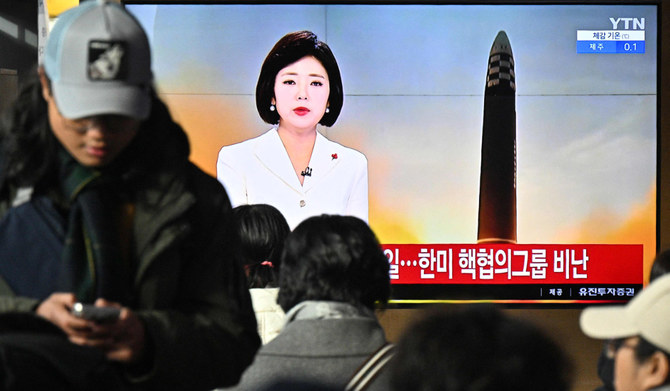
- ARAB NEWS
- 06 May 2024

SEOUL/TOKYO: North Korea fired what appeared to be a long-range ballistic missile on Monday, South Korea and Japan said, its second missile launch in less than 12 hours as Pyongyang condemned a US-led show of force against the nuclear armed state.
The missile was fired from an area near the capital Pyongyang toward the sea off the North’s east coast and flew about 1,000 km (621 miles), South Korea’s Joint Chiefs of Staff said.
Japan’s coast guard said the suspected missile fell into the sea west of Hokkaido about an hour after launch.
Japan’s NHK broadcaster said the missile reached a maximum altitude of more than 6,000 km (3,728 miles), citing government officials.
NHK reported officials as saying it was likely an intercontinental ballistic missile (ICBM), which would underscore the North’s efforts to advance its arsenal with longer range weapons that could potentially reach the mainland United States.
A missile fired at a lofted trajectory with such an apogee likely means the projectile is capable of reaching 15,000 km (9,321 miles) on a normal trajectory, according to expert analysis of previous North Korean long-range missile test launches.
The area near the international airport serving Pyongyang is where the North previously launched ICBMs and is suspected to be the location of a missile assembly facility.
Last week, South Korea’s deputy national security adviser said the North may be readying to launch an ICBM this month, declining to provide any details.
Monday’s missile launch came after North Korea fired a short-range ballistic missile on Sunday night, flying about 570 km and falling into the ocean.
North Korea followed up that launch with a fiery statement condemning the United States for orchestrating what it called a “preview of a nuclear war,” including the arrival of a nuclear-powered submarine in South Korea on Sunday.
USSUBMARINE VISITS SOUTH KOREA
On Friday, following a high-level meeting by US and South Korean officials on the use of US strategic military weapons to deter North Korea’s military threat, Washington warned any nuclear attack would lead to the end of the regime.
South Korea condemned the latest missile launches as a violation of UN Security Council resolutions that ban the use of ballistic missile technology, which Pyongyang rejects as an infringement of its right to self defense.
After the late-night launch, North Korea’s defense ministry criticized “military gangsters” in the United States and South Korea for raising tensions with drills, displays of force, and nuclear war planning.
The statement by an unnamed ministry spokesman cited the arrival of the US nuclear-powered submarine Missouri in the South Korean port city of Busan on Sunday.
Visits by US nuclear submarines had previously been rare, but they have increased under agreements between Seoul and Washington that have boosted the arrivals of US military assets.
The USS Carl Vinson, a US aircraft carrier, also arrived at Busan last month as part of an effort to increase deterrence against North Korea’s nuclear and missile programs.
The North Korean defense ministry also condemned the meeting by South Korean and US officials in Washington as yet another sign of efforts to streamline war preparations and a provocative show of force.
The United States and South Korea have increased the intensity of joint military drills against rising threats from the North, which had tested a range of ballistic missiles and in November launched its first military spy satellite.
Pyongyang tested a long-range ballistic missile in July, which analysts said was a successful launch of a solid-fuel ICBM that flew on a lofted trajectory and reached an altitude of 6,648 km (4,131 miles) before dropping into the sea east of the Korean Peninsula.
Reuters